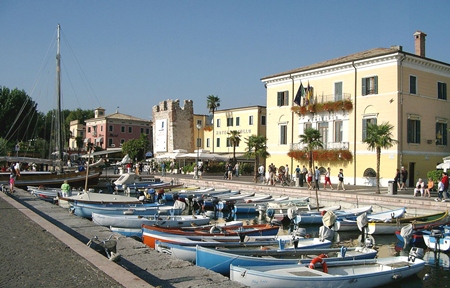Right then. Here’s today’s quiz question, so please sit up and take notice, especially those people shuffling around in the back row. What do these three things have in common; the Corvina, the Molinara and the Rondinella? If your answer is that they were all Toyota models from the 1970’s that would have been a very imaginative and compelling answer. Sadly, it would also have been completely wrong. Let me give you a clue: this is a wine column (You could have fooled me – Ed.)
The Corvina, Molinara and Rondinella are not only Italian grape varieties, but also they’re the main grapes in the Italian red wine from Bardolino. If you got that all right, congratulations! Pick up your fifty baht prize money at the door on your way out.
 The promenade at Bardolino. (Photo: Bhayer)
The promenade at Bardolino. (Photo: Bhayer)
The very name Bardolino (bar-doh-LEE-noh) takes me back years, when it was one of my favourite wines to drink with pizza, along with Chianti and Valpolicella. After a hard day’s work, several of us used to traipse over to a well-known pizza haunt near London’s British Museum. On a summer’s evening, a Bardolino is perfect with pizza.
Palazzo Grimani Bardolino 2011 (red), Italy (Bt 499 @ Big C Extra)
Although you could be forgiven for assuming that Bardolino is the name of yet another Italian grape, it’s actually a place; a small and pleasant town on the eastern shores of Lake Garda, about 100 miles west of Venice. The cool and fresh climate there produces a wine that is light and fruity (or supposed to be) with a sharp cherry-like herby flavour.
Named after the sixteenth-century Venetian palace of the Grimani family, this wine is a medium ruby-red with the aromas of redcurrants, cherries and a typical herby aroma of brambles. The wine is very dry, light-bodied and with a touch of sharpness, giving it a refreshing quality. There’s quite a bit of red fruit on the palate and just the slightest touch of soft tannins. It’s only 12.5% alcohol content, but I always think of Bardolino as a food wine, because of the inherent sharpness on the taste. If you enjoy pasta in a creamy sauce, this wine makes an excellent accompaniment. It was a perfect partner for a recent Tagliatelle alle Erbette, served with a rich, creamy home-made bacon and mushroom sauce to which a few bits of red chili had been added to give it a sense of joie de vivre. For colour and extra flavour, I sprinkled a few fresh bergamot leaves on the top. I know it’s a Festival of Cholesterol, but it’s only once in a while.
Pasqua Sangiovese 2011 (red), Italy (Bt. 399 @ Big C Extra)
Unlike Bardolino, Sangiovese is not a place but a grape. To be more accurate, it’s the most famous and widely planted red wine grape in Italy. It’s also famously mispronounced, because most foreigners give it five syllables instead of four. The correct pronunciation is “san-jo-VAY-zeh” with four syllables. If you also wave your arms around when you say it, people will assume that you speak Italian fluently.
Although Sangiovese reaches its peak in wines like Vino Nobile di Montepulciano and Chianti Classico, the vine has many genetic variations which vary in both style and quality. This one comes from Puglia, which forms the “heel” of Italy’s boot-shaped outline. For years, Puglia has been a major producer of bulk wines which are trundled off in tanker loads to Northern Italy and beyond. Despite (or perhaps because of) it’s consistently hot dry weather, Puglia doesn’t have much of a reputation for fine wines.
This is a typical southern Sangiovese, with its rather rustic aroma of ripe berries, currants and cherries and some background aromas of herbs and mint. It’s a cheap and fairly cheerful wine with only the slightest touch of tannin. There’s a very lively mouth-feel, because of Sangiovese’s relatively high acidity. However, it works well with food and would be completely at home with tomato-based pasta and pizza sauces. But don’t forget the fresh bergamot.
By the way, you can grow bergamot at home if you can find a cool sheltered spot with dappled sunlight. Buy some fresh sprigs at the supermarket (with the roots intact) and stick them in a tub of light soil. Give them plenty of water and although they’ll look half-dead for a few days, they’ll probably perk up and you’ll have your own supply of aromatic bergamot leaves. The plant grows vigorously so after a few months, you should be able to open a small shop. And because it was my suggestion, a very reasonable 10% of your profits would be much appreciated.




